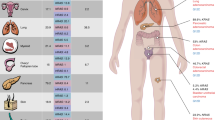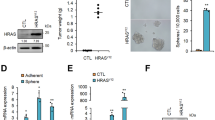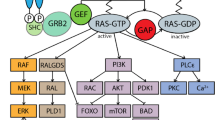Abstract
Mutational activation of ras genes is required for the onset and maintenance of different malignancies. Here we show, using a combination of molecular physiology, nutritional perturbations and transcriptional profiling, that full penetrance of phenotypes related to oncogenic Ras activation, including the shift of carbon metabolism towards fermentation and upregulation of key cell cycle regulators, is dependent upon glucose availability. These responses are induced by Ras activation, being specifically reverted by downregulation of the Ras pathway obtained through the expression of a dominant-negative Ras-specific guanine nucleotide exchange protein. Our data allow to link directly to ras activation the alteration in energy metabolism of cancer cells, their fragility towards glucose shortage and ensuing apoptotic death.
This is a preview of subscription content, access via your institution
Access options
Subscribe to this journal
Receive 50 print issues and online access
$259.00 per year
only $5.18 per issue
Buy this article
- Purchase on Springer Link
- Instant access to full article PDF
Prices may be subject to local taxes which are calculated during checkout







Similar content being viewed by others
References
Ahmad IM, Aykin-Burns N, Sim JE, Walsh SA, Higashikubo R, Buettner GR et al. (2005). J Biol Chem 280: 4254–4263.
Albanese C, Johnson J, Watanabe G, Eklund N, Vu D, Arnold A et al. (1995). J Biol Chem 270: 23589–23597.
Alberghina L, Chiaradonna F, Vanoni M . (2004). Chembiochem 5: 1322–1333.
Arellano M, Moreno S . (1997). Int J Biochem Cell Biol 29: 559–573.
Baggetto LG . (1992). Biochimie 74: 959–974.
Blackburn RV, Spitz DR, Liu X, Galoforo SS, Sim JE, Ridnour LA et al. (1999). Free Radical Biol Med 26: 419–430.
Blum R, Jacob-Hirsch J, Amariglio N, Rechavi G, Kloog Y . (2005). Cancer Res 65: 999–1006.
Board M, Humm S, Newsholme EA . (1990). Biochem J 265: 503–509.
Bos JL . (1995). Eur J Cancer 31A: 1051–1054.
Bossú P, Vanoni M, Wanke V, Cesaroni MP, Tropea F, Melillo G et al. (2000). Oncogene 19: 2147–2154.
Bracken AP, Ciro M, Cocito A, Helin K . (2004). Trends Biochem Sci 29: 409–417.
Brummelkamp TR, Bernards R, Agami R . (2002). Cancer Cell 2: 243–247.
Carmeliet P, Dor Y, Herbert JM, Fukumura D, Brusselmans K, Dewerchin M et al. (1998). Nature 394: 485–490.
Chang F, McCubrey JA . (2001). Oncogene 20: 4354–4364.
Chen C, Xie Y, Stevenson MA, Auron PE, Calderwood SK . (1997). J Biol Chem 272: 26803–26806.
Cheng M, Olivier P, Diehl JA, Fero M, Roussel MF, Roberts JM et al. (1999). EMBO J 18: 1571–1583.
Chiaradonna F, Magnani C, Sacco E, Manzoni R, Alberghina L, Vanoni M . (2005). Biochem Soc Trans 33: 297–299.
Cochet O, Gruel N, Fridman WH, Teillaud JL . (1999). Cancer Detect Prev 23: 506–510.
Dang CV, Semenza GL . (1999). Trends Biochem Sci 24: 68–72.
Darzynkiewics Z . (1992). Cytometry 13: 795–808.
de Vries JE, ten Kate J, Bosman FT . (1996). Pathol Res Pract 192: 658–668.
Downward J . (2003). Nat Rev Cancer 3: 11–22.
Dyson N . (1998). Genes Dev 12: 2245–2262.
Feig LA . (1994). Curr Opin Cell Biol 6: 204–211.
Gatenby RA, Gillies RJ . (2004). Nat Rev Cancer 4: 891–899.
Grunicke HH, Maly K . (1993). Crit Rev Oncogen 4: 389–402.
Hanahan D, Weinberg RA . (2000). Cell 100: 57–70.
Harris AL . (2002). Nat Rev Cancer 2: 38–47.
Hellerstein MK, Murphy E . (2004). Curr Opin Mol Ther 6: 249–264.
Hlavata L, Aguilaniu H, Pichova A, Nystrom T . (2003). EMBO J 22: 3337–3345.
Jinno S, Hung SC, Yamamoto H, Lin J, Nagata A, Okayama H . (1999). Proc Natl Acad Sci USA 96: 13197–13202.
Kahn S, Yamamoto F, Almoguera C, Winter E, Forrester K, Jordano J et al. (1987). Anticancer Res 7: 639–652.
Kato-Stankiewicz J, Hakimi I, Zhi G, Zhang J, Serebriiskii I, Guo L et al. (2002). Proc Natl Acad Sci USA 99: 14398–14403.
Kerkhoff E, Rapp UR . (1998). Oncogene 17: 1457–1462.
Kijima H, Yamazaki H, Nakamura M, Scanlon KJ, Osamura RY, Ueyama Y . (2004). Int J Oncol 24: 559–564.
Kita K, Saito S, Morioka CY, Watanabe A . (1999). Int J Cancer 80: 553–558.
Kitano H . (2004). Nat Rev Cancer 4: 227–235.
Kivinen L, Tsubari M, Haapajarvi T, Datto MB, Wang XF, Laiho M . (1999). Oncogene 18: 6252–6261.
Kocher HM, Senkus R, Al-Nawab M, Hendry BM . (2005). Nephrol Dial Transplant 20: 886–891.
Laemmli UK . (1970). Nature 227: 680–685.
Lee JW, Bae SH, Jeong JW, Kim SH, Kim KW . (2004). Exp Mol Med 36: 1–12.
Lee YJ, Galoforo SS, Berns CM, Chen JC, Davis BH, Sim JE et al. (1998a). J Biol Chem 273: 5294–5299.
Lee YJ, Galoforo SS, Berns CM, Chen JC, Davis BH, Sim JE et al. (1998b). J Biol Chem 273: 5294–5299.
Liang J, Zubovitz J, Petrocelli T, Kotchetkov R, Connor MK, Han K et al. (2002). Nat Med 8: 1153–1160.
Lowy DR, Willumsen BM . (1993). Annu Rev Biochem 62: 851–891.
Mabuchi T, Ichimura Y, Takeda M, Douglas MG . (2000). J Biol Chem 275: 10492–10497.
Mathupala SP, Rempel A, Pedersen PL . (1997). J Bioenerg Biomembr 29: 339–343.
Mazurek S, Eigenbrodt E . (2003). Anticancer Res 23: 1149–1154.
Mazurek S, Eigenbrodt E, Failing K, Steinberg P . (1999). J Cell Physiol 181: 136–146.
Messer JI, Jackman MR, Willis WT . (2004). Am J Physiol Cell Physiol 286: C565–72.
Monia BP, Johnston JF, Ecker DJ, Zounes MA, Lima WF, Freier SM . (1992). J Biol Chem 267: 19954–19962.
Nheu T, He H, Hirokawa Y, Walker F, Wood J, Maruta H . (2004). Cell Cycle 3: 71–74.
Osthus RC, Shim H, Kim S, Li Q, Reddy R, Mukherjee M et al. (2000). J Biol Chem 275: 21797–21800.
Pulciani S, Santos E, Long LK, Sorrentino V, Barbacid M (1985). Mol Cell Biol 5: 2836–2841.
Rajendran JG, Mankoff DA, O'Sullivan F, Peterson LM, Schwartz DL, Conrad EU et al. (2004). Clin Cancer Res 10: 2245–2252.
Ramanathan A, Wang C, Schreiber SL . (2005). Proc Natl Acad Sci USA 102: 5992–5997.
Rebollo A, Perez-Sala D, Martinez AC . (1999). Oncogene 18: 4930–4939.
Reuther GW, Der CJ . (2000). Curr Opin Cell Biol 12: 157–165.
Robey IF, Lien AD, Welsh SJ, Baggett BK, Gillies RJ . (2005). Neoplasia 7: 324–330.
Rodenhuis S . (1992). Semin Cancer Biol 3: 241–247.
Rolland F, Winderickx J, Thevelein JM . (2002). FEMS Yeast Res 2: 183–201.
Roovers K, Assoian RK . (2000). Bioessays 22: 818–826.
Russell JS, Lang FF, Huet T, Janicot M, Chada S, Wilson DR et al. (1999). Cancer Res 59: 5239–5244.
Scheffzek K, Ahmadian MR, Kabsch W, Wiesmuller L, Lautwein A, Schmitz F et al. (1997). Science 277: 333–338.
Serrano M, Lin AW, McCurrach ME, Beach D, Lowe SW . (1997). Cell 88: 593–602.
Shin I, Yakes FM, Rojo F, Shin NY, Bakin AV, Baselga J et al. (2002). Nat Med 8: 1145–1152.
Shoshan-Barmatz V, Gincel D . (2003). Cell Biochem Biophys 39: 279–292.
Spitz DR, Sim JE, Ridnour LA, Galoforo SS, Lee YJ . (2000). Ann NY Acad Sci 899: 349–362.
Takeuchi M, Shichinohe T, Senmaru N, Miyamoto M, Fujita H, Takimoto M et al. (2000). Gene Therapy 7: 518–526.
Takuwa N, Takuwa Y . (2001). Mol Cell Endocrinol 177: 25–33.
Thomas S, Fell DA . (1998). Eur J Biochem 258: 956–967.
Vander Heiden MG, Chandel NS, Li XX, Schumacker PT, Colombini M, Thompson CB . (2000). Proc Natl Acad Sci USA 97: 4666–4671.
Vanoni M, Bertini R, Sacco E, Fontanella L, Rieppi M, Colombo S et al. (1999). J Biol Chem 274: 36656–36662.
Viglietto G, Motti ML, Bruni P, Melillo RM, D'Alessio A, Califano D et al. (2002). Nat Med 8: 1136–1144.
Warburg O . (1956). Science 123: 309–314.
Yamamoto F, Perucho M . (1984). Nucleic Acids Res 12: 8873–8885.
Acknowledgements
We thank Chiara Magnani for technical assistance and discussion. This work has been supported by grants to LA (AIRC, Cariplo and MIUR-Progetto Strategico Oncologia) and to MV (MIUR). ES has been supported by a fellowship from FIRC.
Author information
Authors and Affiliations
Corresponding author
Additional information
Supplementary Information accompanies the paper on the Oncogene website (http://www.nature.com/onc).
Rights and permissions
About this article
Cite this article
Chiaradonna, F., Sacco, E., Manzoni, R. et al. Ras-dependent carbon metabolism and transformation in mouse fibroblasts. Oncogene 25, 5391–5404 (2006). https://doi.org/10.1038/sj.onc.1209528
Received:
Revised:
Accepted:
Published:
Issue Date:
DOI: https://doi.org/10.1038/sj.onc.1209528
Keywords
This article is cited by
-
Effect of differential deprivation of nutrients on cellular proliferation, oxidative stress, mitochondrial function, and cell migration in MDA-MB-231, HepG2, and HeLa cells
3 Biotech (2023)
-
Multifaceted roles of mitochondrial dysfunction in diseases: from powerhouses to saboteurs
Archives of Pharmacal Research (2023)
-
RIP140 inhibits glycolysis-dependent proliferation of breast cancer cells by regulating GLUT3 expression through transcriptional crosstalk between hypoxia induced factor and p53
Cellular and Molecular Life Sciences (2022)
-
Reduced replication origin licensing selectively kills KRAS-mutant colorectal cancer cells via mitotic catastrophe
Cell Death & Disease (2020)
-
Alterations of mTOR signaling impact metabolic stress resistance in colorectal carcinomas with BRAF and KRAS mutations
Scientific Reports (2018)



